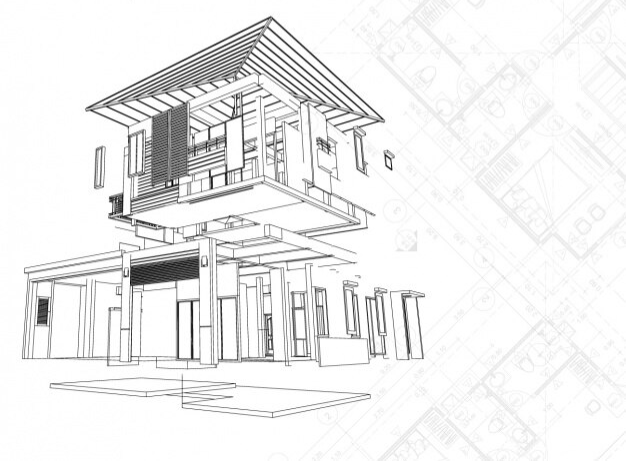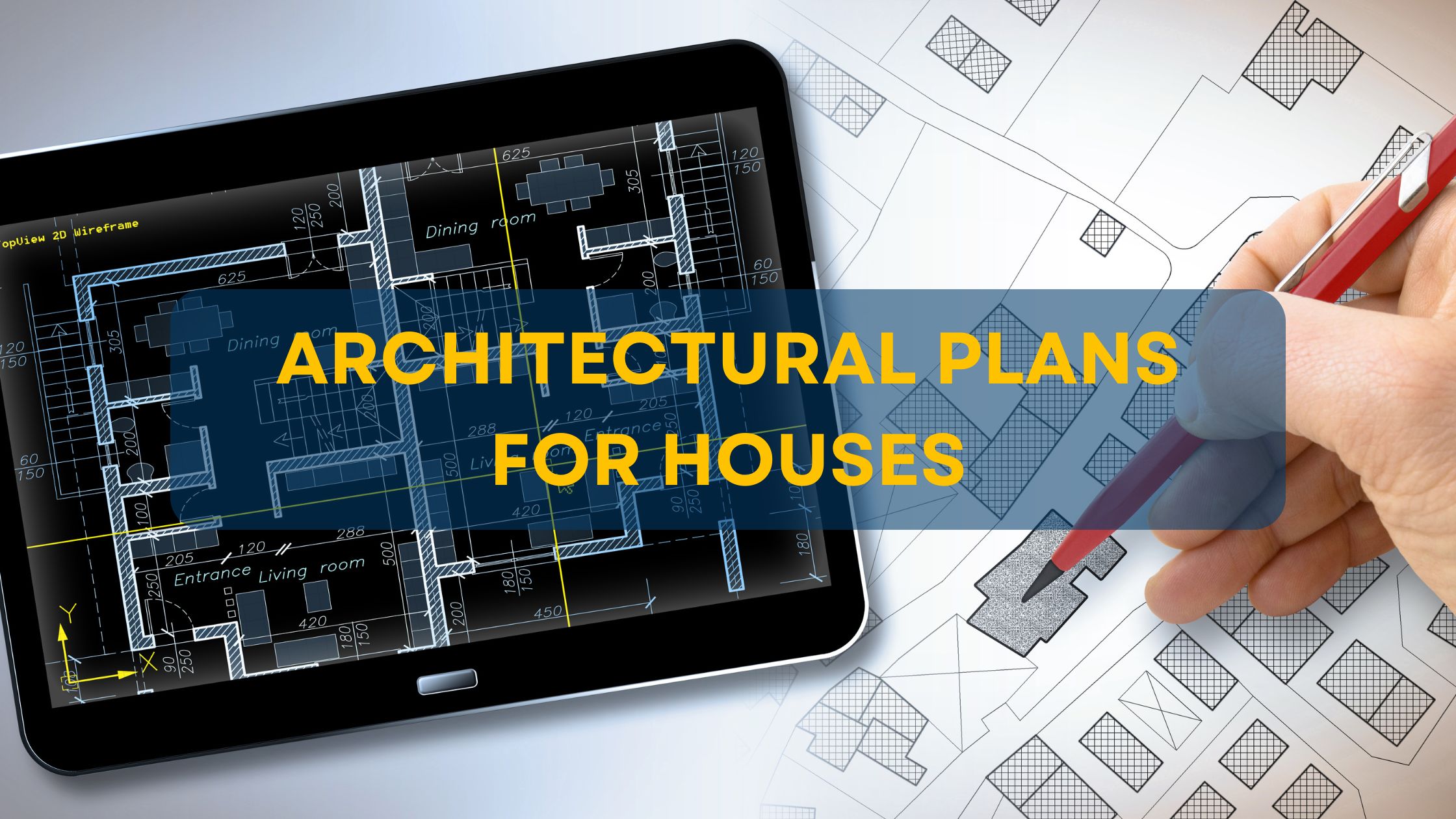When constructing a house, architectural plans serve as the blueprint that guides the entire process, from design to completion. Whether you’re a homeowner, builder, or designer, understanding architectural drawings is essential for bringing a vision to life.
In this blog, we will explore the meaning, importance, types, and elements of architectural drawings, along with how to read a building plan effectively.
What is an Architectural Drawing?
An architectural drawing is a technical representation of a building’s design, structure, and layout. These drawings provide a detailed visual guide that includes dimensions, materials, and construction details. Architects create these drawings to communicate their designs with engineers, contractors, and clients. These drawings serve as a blueprint for construction, guiding engineers, contractor s, and builders through the construction process.
Architectural plans consist of various drawings, including floor plans, elevations, sections, and site plans, each serving a unique purpose in the construction process.
Importance of Architectural Drawings
Architectural drawings play a fundamental role in the construction and design process. They act as a bridge between an idea and its physical realization, ensuring that every aspect of a building is carefully planned and executed. Here’s why they are crucial:
1. Clear Communication
One of the primary functions of architectural drawings is to establish a common understanding between all stakeholders involved in a project. Architects, engineers, builders, and clients all rely on these drawings to interpret the design accurately. They act as a universal language that removes ambiguity and ensures that everyone is aligned with the project’s goals and specifications. This helps avoid misunderstandings that could lead to costly mistakes during construction.
2. Detailed Planning
A well-structured architectural drawing serves as a roadmap for construction. It provides intricate details about the dimensions, layout, and materials, ensuring that every element is precisely planned before work begins. This level of detail helps:
Minimize errors during construction
Ensure accurate placement of rooms, walls, windows, and doors
Align structural components with mechanical, electrical, and plumbing (MEP) systems
Reduce wastage of materials and resources
By having a clear plan, the entire construction process becomes more organized and efficient.
3. Legal Approval and Permits
Before any construction begins, legal permissions must be obtained from local authorities. Architectural drawings play a crucial role in securing these approvals by demonstrating that the project complies with:
· Zoning laws – Ensuring the building is constructed within designated zones (residential, commercial, industrial, etc.)
· Building codes and regulations – Adhering to safety standards, structural stability, and fire protection requirements
· Environmental impact guidelines – Ensuring proper waste management and sustainable construction practices
Without properly drafted architectural plans, construction projects may face delays, penalties, or even legal action due to non-compliance with regulations.
4. Cost Estimation
A well-detailed architectural plan helps in accurately estimating:
· Material costs – The quantity and type of construction materials required
· Labor costs – The workforce needed for various stages of construction
· Project timeline – The duration of each phase, preventing unexpected delays
· Budget management – Preventing overspending and ensuring efficient allocation of funds
By analyzing the architectural drawings, builders and project managers can prepare a realistic budget, reducing financial uncertainties and preventing cost overruns.
5. Efficient Construction Process
With architectural drawings serving as a guiding blueprint, the construction process becomes highly efficient. Builders can:
· Follow step-by-step construction sequences
· Reduce errors that could lead to rework and material wastage
· Ensure proper coordination between different trades such as electricians, plumbers, and carpenters
· Maintain project timelines, ensuring timely completion
When builders have clear instructions on structural components, electrical layouts, plumbing systems, and interior design, they can work more effectively, minimizing delays and disruptions.
6. Visualization of the Final Structure
For clients and investors, architectural drawings provide a realistic representation of how the finished building will look. These drawings help in:
· Understanding the overall layout and space utilization
· Making informed decisions about design changes before construction starts
· Choosing materials, colors, and textures for interiors and exteriors
· Enhancing client satisfaction by ensuring their expectations are met
Modern architectural tools, including 3D renderings and virtual walkthroughs, allow clients to experience the structure before it’s built, enabling them to suggest modifications early in the process.
7. Future Modifications and Renovations
Architectural drawings serve as a permanent record of the building’s structure, which is invaluable for future renovations, expansions, or repairs. They help in:
· Understanding the load-bearing capacity before making structural changes
· Identifying plumbing and electrical layouts before installing new fixtures
· Ensuring compliance with building codes for new modifications
· Maintaining the architectural integrity of the house during renovations
Types of Architectural Drawings
Architectural drawings are essential blueprints that guide the construction and design of a building. Different types of architectural drawings serve specific purposes, ensuring precision and efficiency in the building process. Below, we explore some of the most important types of architectural drawings in detail.
1. Site Plan
A site plan provides an aerial view of the entire property, including the building, surrounding landscape, and other site elements. It helps in understanding how the house fits within its environment and ensures proper planning for accessibility and utility connections.
Key Elements of a Site Plan:
· Property boundaries – Defines the legal limits of the land
· Building footprint – Shows the exact placement of the house on the plot
· Driveways, pathways, and parking spaces – Helps in planning outdoor movement
· Landscaping details – Includes trees, gardens, and outdoor features
· Drainage and utility connections – Shows water, sewage, gas, and electricity lines
A well-designed site plan ensures compliance with zoning regulations and helps optimize space utilization.
2. Floor Plan
A floor plan is a two-dimensional, top-down view of a building that displays the layout of rooms, doors, windows, and furniture arrangements. It acts as a primary reference for builders and interior designers to structure the living space effectively.
Key Elements of a Floor Plan:
· Room layout – Shows the placement and function of each room
· Doors and windows – Indicate their position and size
· Furniture layout – Provides an idea of how spaces can be utilized
· Wall thickness and dimensions – Helps in understanding the structural aspects
Floor plans are essential for homeowners to visualize the arrangement of spaces before construction begins.
3. Elevation Drawings
Elevation drawings provide a side view of the building’s exterior, showcasing design aesthetics and structural details. These drawings are typically made from multiple angles to represent the front, back, and sides of the building.
Key Elements of Elevation Drawings:
· Exterior walls and finishes – Show materials like bricks, glass, or wood
· Roof design – Displays slopes, angles, and any decorative elements
· Windows and doors – Their position, size, and design
· Height dimensions – Indicate the overall height of the structure
Elevation drawings help clients and architects finalize the external appearance of the house.
4. Section Drawings
Section drawings provide a cross-sectional view of the building, cutting through walls and floors to reveal internal components. These drawings help engineers and builders understand the hidden structural elements that are not visible in other plans.
Key Elements of Section Drawings:
· Interior walls and partitions – Show thickness and material details
· Floor levels – Indicate different floor heights and slab thickness
· Ceiling heights and roof structure – Help in planning ventilation and insulation
· Hidden elements – Include beams, columns, insulation, and plumbing systems
Section drawings are vital for ensuring proper alignment of floors, ceilings, and support structures.
5. Detail Drawings
Detail drawings focus on specific architectural features that require precise construction. They provide in-depth instructions on complex elements such as staircases, decorative moldings, and custom-built structures.
Common Elements in Detail Drawings:
· Staircase details – Tread width, riser height, railing design
· Window and door sections – Frame design, opening mechanism
· Kitchen and cabinetry layouts – Placement of countertops, cabinets, and storage spaces
· Wall sections – Materials, insulation, and finishing layers
These drawings ensure accuracy in crafting intricate architectural components.
6. Electrical and Plumbing Plans
Electrical and plumbing plans are specialized drawings that guide the installation of wiring, lighting, water supply, and drainage systems.
Key Elements of Electrical Plans:
· Wiring layouts – Placement of electrical circuits and conduit paths
· Lighting fixtures and outlets – Position of bulbs, fans, and switches
· Fuse boxes and circuit breakers – Ensure electrical safety
Key Elements of Plumbing Plans:
· Piping systems – Water supply and drainage lines
· Fixtures – Sinks, toilets, bathtubs, and showers
· Water heater placement – Shows location and connection details
These plans are essential for ensuring proper utility setup and compliance with safety standards.
7. Structural Drawings
Structural drawings define the framework of a building, detailing the load-bearing elements that ensure the structure’s stability and durability.
Key Elements of Structural Drawings:
· Foundation plan – Layout of footings, slab thickness, and materials
· Beam and column layout – Specifies sizes and placement for load distribution
· Roof framing – Shows rafters, trusses, and support structures
· Wall sections – Indicate reinforcement details for strength
· Material specifications – Includes concrete mix, steel grades, and reinforcement details
Structural drawings prevent building failures by ensuring proper weight distribution and earthquake resistance.
Elements of a Building Plan
A building plan is a detailed architectural drawing that provides essential information about a structure’s design, layout, and dimensions. Understanding the key elements of a building plan is crucial for architects, engineers, builders, and even homeowners, as it helps interpret the design accurately.
Below, we explore the main elements of a building plan and how to read these drawings effectively.
1. Title Block
The title block is one of the most important sections of a building plan, typically located at the bottom or side of the drawing. It contains essential project details and serves as a reference for all stakeholders involved.
2. Legend and Symbols
Architectural plans contain various symbols and abbreviations that represent different components of the building, such as doors, windows, electrical outlets, and plumbing fixtures. A legend or key explains these symbols, ensuring clarity.
3. Scale and Dimensions
Since buildings are too large to be drawn at full size, architectural plans use a scale to represent real-world dimensions in a manageable format.
4. Walls and Openings (Doors & Windows)
The walls in a building plan define the layout and structural integrity of the house. Openings such as doors and windows are also marked clearly to show their placement.
5. Room Labels
Each room or space in the building plan is labeled to indicate its intended function. This ensures clarity for homeowners, builders, and designers.
6. Sections and Elevations
Architectural drawings include sections and elevation views to provide a vertical perspective of the building.

How to Read a Building Plan Drawing
Now that we’ve covered the essential elements, let’s go over a step-by-step guide to reading a building plan effectively.
Step 1: Check the Title Block
· Identify the project name, scale, and architect’s details.
· Ensure the drawing version is up to date.
Step 2: Understand the Scale and Dimensions
· Determine the scale ratio and convert it to real-world measurements.
· Check overall dimensions to understand the size of the building.
Step 3: Analyze the Floor Plan
· Identify walls, doors, and windows to understand room layouts.
· Note the placement of furniture and fixtures for space planning.
Step 4: Review Symbols and Legends
· Cross-check symbols with the legend to interpret electrical, plumbing, and mechanical details.
· Ensure proper placement of outlets, lighting, and plumbing systems.
Step 5: Examine Sections and Elevations
· Look at exterior elevations to visualize the building’s height and design.
· Study section views to understand interior components like walls, floors, and ceilings.
Step 6: Verify Compliance and Accuracy
· Ensure that the plan follows building codes and zoning regulations.
· Check for errors or inconsistencies before beginning construction.
Getting the Best House Plan Drawing – Contact Nammane Constructions
If you’re looking for expert guidance in designing the perfect house plan, Nammane Constructions is the ideal choice. With a team of skilled architects and engineers, they specialize in creating customized home designs tailored to your needs. Whether you need a modern, traditional, or eco-friendly house plan, Nammane Constructions ensures precision, quality, and compliance with building regulations.
Conclusion
Architectural drawings are the foundation of any successful construction project. Understanding different types of architectural plans, their importance, and how to read them ensures a smooth building process. If you’re planning to build your dream home, investing in a professionally designed house plan from Nammane Constructions can make all the difference. With the right architectural plan, you can bring your vision to life with clarity, efficiency, and confidence.




